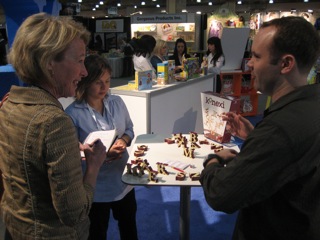 Today I had a press opportunity to have tea with and listen to TIA’s (Toy Industry Association) Toy Trend Specialist, Reyne Rice, talk about the current trends in kids’ toys. Ironically, I had blogged about the same subject last night, based on what I saw after one day at the Toy Fair. I’m proud to say that our lists overlapped a bit!
Today I had a press opportunity to have tea with and listen to TIA’s (Toy Industry Association) Toy Trend Specialist, Reyne Rice, talk about the current trends in kids’ toys. Ironically, I had blogged about the same subject last night, based on what I saw after one day at the Toy Fair. I’m proud to say that our lists overlapped a bit!
Reyne knows her subject well and enlightened us with the following four trends she sees, supported by brands:
- Active. We are seeing exercise being brought into toys. This goes along with Michelle Obama’s initiative to reduce childhood obesity and increase movement in kids. Active imagination is in this category which includes arts and crafts and construction. “We are seeing creativity coming back into the fray.” Wild Planet, Hasbro and Mattel all emphasize products that get kids moving. Many companies might use some technology to start the movement. She went on to say that construction toys, arts and crafts, puzzles and games showed the most growth last year in the toy industry. Brands like Crayola, Mega blocks, Playmobil and Legos all encourage active imagination. Active brain includes puzzles like the Rubik’s Cube. We are also seeing games that encourage intergenerational play, providing different levels of difficulty, so various ages can play simultaneously.
- Accessible. We are seeing toys and games whose themes are accessible 24 hours a day, 7 days a week. Kids can go online and play games, or get information on their favorite brands. The hot toy unveiled today was Fisher Price’s new iXL which is their “multi-tech, six-in-one smart device for preschoolers,” according to Robert Eckert, CEO of Mattel. This portable learning unit comes with six applications. It can be used as a photo album or first e-reader product for kids 3 and up. In addition, following this accessible trend, games are being offered with options to play them cooperatively–extending the value of the game.
- Affordable. There are many toys and games coming out in the $10, $15 and $20 range. Twister
 Hoops by Hasbro has 5 ways to play the game, extending its play value. According to Rice, it’s the details that delight kids so companies have introduced 3 3/4 inch action figures which have more detail in sculpting and therefore attract more interest. Rice talked about “pennies per play,” the idea of getting repeated value out of a toy or game. Construction toys can be played with in a different way each time. And speaking of the flexibility of construction, several games introduced require the participants to build the game–Lego has buildable mazes and Hasbro’s Mousetrap allows the players to make the gameboard.
Hoops by Hasbro has 5 ways to play the game, extending its play value. According to Rice, it’s the details that delight kids so companies have introduced 3 3/4 inch action figures which have more detail in sculpting and therefore attract more interest. Rice talked about “pennies per play,” the idea of getting repeated value out of a toy or game. Construction toys can be played with in a different way each time. And speaking of the flexibility of construction, several games introduced require the participants to build the game–Lego has buildable mazes and Hasbro’s Mousetrap allows the players to make the gameboard. - Aspirational. Toys and games are teaching kids about empowerment. “I Can Be Barbie” comes in 125 careers. Girls can go online and read about women and the path they took to arrive at their careers. “The Princess and the Frog” teaches perseverance. According to Rice, brands build in, “There’s a choice,” because when children get older they have to make decisions. Also, curriculum based products are in vogue now. You not only can make a light saber, you can learn the physics behind its operation. Thinkfun is giving curriculum to educators and after school programs to extend their products. I met the woman who is heading up the link between their games and learning. She taught kindergarten through second grade and was getting her degree in curriculum when she interned for ThinkFun. The rest is history. She writes the instruction booklets included in the games on how to promote further learning. Good for ThinkFun! Many companies are involved in charitable giving–contributing 3-5% or even 10% of their profits to charities. Karito Kids allows a child who has purchased one of their dolls to log onto the website and choose the charity where she can apply 3% of her purchase price. Included in the aspirational trend are the eco-friendly products. These are made from organic materials, in sustainable factories, with soy based inks, wood, bamboo, etc. Rice cited the example of a company named TDC which offers a green puzzle, where literally when you have worn out the puzzle, you can go outside and plant the puzzle pieces which each have a seed embedded in it. Now that’s what I call recycling.



